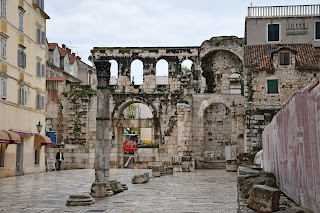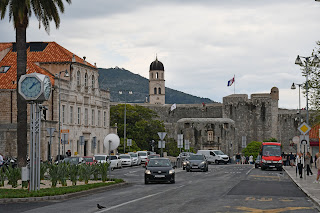Balkans Road Trip: Day 7 – Split and Dubrovnik
There were a few things we did not get to see yesterday in Split due to our late arrival. After buying our breakfast from a local bakery, therefore, we made a visit to Saint Domnius Cathedral. A service had just ended there, and the lights were being turned off as we walked in, but at least we had a moment to enjoy the sacred space all by ourselves. An interesting feature of the exterior is that at the foot of the western gate stand two lions, one of them trampling a lamb. I am not quite sure what that is meant to evoke but it seems perverse.
We also attempted to
visit Jupiter’s Temple and Diocletian’s Cellars, but both were still closed. We
walked through the city to waste some time, stopping by Republic Square and
People’s Square. When we returned to the cellars, however, we were told that
the official opening times were wrong, and we would have to wait at least
another half an hour. Continuing our procrastination seemed like a sunk cost
fallacy, so we decided to return to the car and drive to our next destination.
The distance from
Split to Dubrovnik is about three hours by car when one takes the tolled
highways and skirts Bosnia: contrary to my expectations, it is possible to travel
to Dubrovnik from Croatia without crossing the border by using the Pelješac
Bridge. The bridge, which we dubbed the BBB, the Bypass Bosnia Bridge, seems to
be a popular one, garnering over 700 reviews on Google and a 4.9-star rating. We
could draw conclusions from that, but we will not.
It rained for much of
our ride, sometimes so heavily that I could barely see the road in front of me.
By the time we reached Dubrovnik, however, the weather became more reasonable. We
walked to the old town and ate lunch, after which we traversed the city from
east to west and back again. Since we figured we would leave the palaces and
walls for the next day, we visited a few of Dubrovnik’s famous religious sites.
However, this still did not take up enough time, so we took the cable car to
Mount Srdj and walked around the coast after getting back down again.
Dubrovnik – despite a
fame that surpasses all other Croatian coastal cities – is not remarkably
dissimilar to the rest. It is not fantastically bigger, and its churches might actually
be a little less ornate that some we have seen; what makes it special are its
giant walls and its remarkable history as a free state. Of course, many
American tourists we have heard today associate the city only with a certain
fantasy TV show, and being subjected to hearing about it while trapped in a
cable car is rather annoying.


















































Comments
Post a Comment